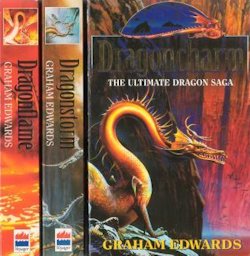Welcome back to the British Genre Fiction Focus, Tor.com’s weekly column dedicated to news and new releases from the United Kingdom’s thriving speculative fiction industry.
This week, image is everything—or so says John Dugdale, who in the aftermath of Inferno considered the significance of Robert Langdon’s Harris Tweed jacket vis-à-vis the visibility of Dan Brown’s protagonist. I want to know which figures from genre fiction have apparel even half as iconic.
Later on, in Cover Art Corner, we’ll look ahead to “a gothic fable for all ages” from Carlos Ruiz Zafon, alongside news of two new books Solaris plan to publish next spring, including the author of The Ultimate Dragon Saga’s long-awaited return to genre fiction.
Last but not least, Gollancz have announced that they’re currently undergoing a significant restructure, and I can’t decide whether to offer congratulations or commiserations, because I’m afraid I’ve heard this story before. Someone put my mind at ease, please!
I’ve got a few new releases up my sleeves for you this week as well, not least some previously unpublished poetry by J. R. R. Tolkien, Mur Lafferty’s first novel, and a promising chronicle of Life on the Preservation.
NEWS
Image Is Everything
The recent release of Dan Brown’s new novel, discussed in detail in last week’s edition of the British Genre Fiction Focus, has prompted any number of fascinating reactions in the press and elsewhere. Hell, I could fill a whole column with them if I was of a mind to.
Breathe easy, readers: I’m not.
But I would like to draw your attention towards John Crace’s delightful digested read, and Adam Roberts’ inimitable review of the book over at his new site, Sibilant Fricative, which concludes:
You’ll never get the hours back again
That you spent reading this. Mind you, my job,
Is reading books—I really can’t complain:It’ll fob off only those who value fob.
Maybe the coming film will cast Will Farrell
Instead of dough-faced Hanks as hero, Rob.From Langdon’s bloodstained tweed apparel
At the beginning, to p.461,
Reviewing this is shooting fish-in-barrel.
It’s simply singular stuff; away and read the rest!
But the biggest news of the week isn’t that Adam Roberts is awesome; that was true last time too. He does, however, touch on the subject I’ve decided to begin this edition in earnest with, namely Langdon’s iconic attire, the larger significance of which John Dugdale considered in this article for The Guardian:
The Harris Tweed jacket of Dan Brown’s protagonist Robert Langdon has understandably been mentioned in most reviews of Inferno, with critics noting how often Brown refers to it (not to mention its label: “Harris Tweed’s iconic orb adorned with 13 buttonlike jewels and topped by a Maltese cross”) and its elevation into playing a part in the plot—everything starts with the Harvard professor of “symbology” discovering a titanium case stitched into its lining.
Yet there’s a jeering tone whenever reviewers pick up on what Langdon wears—invariably a turtleneck, khaki trousers and loafers with the jacket, whatever the context—that suggests a lack of appreciation of what Brown is doing, and of the subtle but significant role of clothing in thrillers and crime novels in general.
It’s no accident that you can usually summon up an image of their protagonists (from Sherlock Holmes’ pipe to Sarah Lund’s Faroese jumper), because the writers strive to imprint in our minds a simple visual idea of the hero or heroine, often a single item of clothing or prop. And what they’re eager to get across is both the garment’s and the character’s unsuitability, the one a metaphor for the other. Sleuths and spies are themselves compilations of symbols, as well as readers of them.
You know, I think there’s something to this, too.
Or rather that there was. Between the 60s and 90s, however, as Dugdale asserts, the rise of cinema and television led to literary symbols taking a backseat to the visual image. With a few obvious exceptions:
If you can visualise another protagonist between the 60s and the 90s (eg. Morse, Adam Dalgliesh or VI Warshawski), it’s probably the actor’s face from a screen version, with what they wore making no impression.
That trend, however, has recently been reversed, with a slew of global bestsellers that (just coincidence?) all feature characters made visually memorable: Harry Potter in Hogwarts uniform and round glasses; Langdon saving the planet in his Harvard don costume; Lisbeth Salander in punky-goth outfits, with piercings and tattoos; giant Jack Reacher in workman’s clothes he throws away after one use. It was an indication of how far the pendulum has swung back when Lee Child, Reacher’s creator, recently devoted an entire article to how his macho hero dresses.
Speculative fiction gets a little look-in at the end of Dugdale’s essay, but I think it’s fair to say this critic is overwhelmingly interested in crime and thriller figures, and I’d like to apply his principles to the genres we come to Tor.com to talk about.
How, then, does dress define our icons? Who are they, what do they wear, and what does that say?
Off the top of my head, Arthur Dent in his dressing gown stands a classic example. And then there’s Anomander Rake, with his silver mane and that bastard sword on his back.
Can you folks think of any others?
Solaris Books Two for 2014

With the summer seemingly upon us, if in a rather reduced capacity, and most of the year’s big hitters out already—notwithstanding The Republic of Thieves, Doctor Sleep and a couple of other latecomers—it’s got to be about time to start thinking about what we’ll be reading next year.
Publishers certainly are, as evidenced by the press release the fine folks at Solaris Books let loose last week:
From the dark hills of America to detective stories from the dawn of time, the cutting edge publisher of science-fiction, horror and fantasy, Solaris, has bolstered its Spring 2014 schedule with intriguing acquisitions from two exceptional talents.
Blood Kin by Steve Rasnic Tem will be published in March 2014 and follows last year’s critically-acclaimed novel for Solaris, Deadfall Hotel.
Set in the southern Appalachians of the US, alternating between the 1930s and the present day, Blood Kin is a dark Southern Gothic vision of ghosts, witchcraft, secret powers, snake-handling, Kudzu, Melungeons, and the Great Depression. Michael Gibson returns home following a suicide attempt and now takes care of his sickly grandmother. In a field not far from the Gibson family home lies an iron-bound crate within a small shack buried four feet deep under kudzu vine. Michael somehow understands that hidden inside that crate is potentially his own death, his grandmother’s death, and perhaps the deaths of everyone in the valley if he does not understand her story well enough.
Editor-in-chief of Solaris, Jonathan Oliver, said: “Steve’s Deadfall Hotel was one the highlights of 2012 for Solaris: a moving, powerful and haunting horror novel. Blood Kin, likewise, promises to be something extraordinary. Steve walks in the traditions of such great writers as Ray Bradbury, Theodore Sturgeon and Flannery O’Connor, while enriching the field with his own unique take on genre.”

In addition, after disappearing for in excess of a decade—excepting several short stories—The Ultimate Dragon Saga’s Graham Edwards will return to genre fiction next Spring:
Talus and the Frozen King by Graham Edwards will be published in April next year and tells the story of Talus—the world’s first detective.
A dead warrior king frozen in winter ice. Six grieving sons, each with his own reason to kill. Two weary travellers caught up in a web of suspicion and deceit. In a distant time long before our own, wandering bard Talus and his companion Bran journey to the island realm of Creyak, where the king has been murdered. From clues scattered among the island’s mysterious barrows and stone circles, they begin their search for his killer. Creyak is a place of secrets and spirits, mystery and myth. It will take a clever man indeed to unravel the truth. The kind of man this ancient world has not seen before.
Jon said: “Graham’s novel is a murder mystery like no other. A richly evoked past draws you into this unusual thriller and the characters of Talus and Bran have to be one of the most entertaining crime-fighting duos ever. A startlingly innovative book and a corking good read!”
I’ll admit to more immediate interest in Steve Rasnic Tem’s next novel than the new Edwards myself, but then Deadfall Hotel was released relatively recently, whereas it’s been many, many years since I even thought of Dragoncharm.
Tell you what, though: now that I am thinking of it, I’m in. Roll on Talus and the Frozen King next spring!
Cover Art Corner: A Gothic Tale for All Ages
These days, I’m not sure what to make of Carlos Ruiz Zafon.
I used to believe he was the bee’s knees, and I still have a special place in my heart for The Shadow of the Wind, but everything I’ve read by the bestselling Spanish author since said has left me wondering whether he isn’t simply a one-hit wonder.
The Shadow of the Wind was a hell of a hit, admittedly, but between The Angel’s Game, The Prince of Mist and The Midnight Palace, the returns a reader might be inclined to expect have diminished further and further. I still haven’t gotten around to reading The Prisoner of Heaven, though I remember being excited about its release a year or so ago; I was worried, unreasonably I realise, that it would only sully my recollection of that astonishing first Zafon further.

Long story short, I’m not sure how to describe my interest in Marina, which purports to be a bridge between the series revolving around the Cemetery of Forgotten Books and the disappointing young adult efforts that have been translated into English in recent years. But I do have some—interest, that is. And simple as it seems, the cover art I chanced upon this week is to my mind quite striking.
Here’s the blurb:
“Fifteen years on, the remembrance of that day has returned to me. I have seen that boy wandering through the mist of the railway station, and the name of Marina has flared up again like a fresh wound. We all have a secret buried under lock and key in the attic of our soul. This is mine…”
In May 1980, 15-year-old Oscar Drai suddenly vanishes from his boarding school in the old quarter of Barcelona. For seven days and nights no one knows his whereabouts…
His story begins in the heart of old Barcelona, when he meets Marina and her father German Blau, a portrait painter. Marina takes Oscar to a cemetery to watch a macabre ritual that occurs on the fourth Sunday of each month. At 10AM precisely a coach pulled by black horses appears. From it descends a woman dressed in black, her face shrouded, wearing gloves, holding a single rose. She walks over to a gravestone that bears no name, only the mysterious emblem of a black butterfly with open wings.
When Oscar and Marina decide to follow her they begin a journey that will take them to the heights of a forgotten, post-war Barcelona, a world of aristocrats and actresses, inventors and tycoons; and a dark secret that lies waiting in the mysterious labyrinth beneath the city streets.
Weidenfeld & Nicolson plan to publish Marina this very September, and I aim to give it a fair shake.
Gollancz Restructure

In case you weren’t aware, Weidenfeld & Nicolson is an imprint of the Orion Publishing Group. Gollancz is another, and one rather more in our wheelhouse, so we’re going to close out this section of the British Genre Fiction Focus with the news that they’re implementing some fairly substantial changes.
Per the press release:
Gollancz is pleased to announce a significant structural reorganisation within the editorial team. Simon Spanton is promoted to Associate Publisher, with particular responsibility for innovative acquisitions and Gollancz’s social media and community engagement, as well as continuing to publish his award-winning list to its full potential.
Gillian Redfearn is promoted to Deputy Publishing Director focusing on strategy, critical path delivery and the publishing programme. She will be looking to take Gollancz—already the number one for Science Fiction and Fantasy in the UK—to the next level, while continuing to work as a full time commissioning editor. Both Simon and Gillian continue to report to the Gollancz Publishing Director, Jon Wood.
Charlie Panayiotou is promoted to Editorial Manager.
Jon Wood, Gollancz Publishing Director and Deputy Publisher, Orion Group, said “We believe these changes will better equip the already-thriving Gollancz list for the major challenges of the future. By looking at all the individual roles in the team, we hope to keep on delivering the most professional, most innovative and most successful SF/Fantasy list in UK publishing.”
[…]
Simon Spanton said “I can’t think of a better, more supported and valued genre list than Gollancz. I’m looking forward to concentrating on a new role within that success and supporting Gillian as the entire team prepare for the exciting challenges ahead.”
Congrats are in order, then, to Simon Spanton, Gillian Redfearn and Charlie Panayiotou, too.
That said, I can’t help but feel ever-so-slightly concerned by this development. I may be in danger of making a mountain out of a molehill here, but what are “the exciting challenges ahead,” exactly?
What worries me is that I’m sure I recall reading about another restructuring at Orion relatively recently. My Google-fu is on poor form this morning, but… hang on, I have it! It happened last February. And why would a second facelift be needed if the first one had worked?
On the other hand, this could simply be a case of the changes Orion implemented in 2012 finally filtering down. I really, truly hope so, because Gollancz is indisputably one of the biggest and, yes, bestest proponents of genre fiction in Great Britain. I’d hate to see it lessened in any sense.
Anyone want to weigh in?
With that, let’s look at the week in new releases.
NEW RELEASES

The Fall of Arthur, by J. R. R. Tolkien (May 23, HarperCollins)
The world first publication of a previously unknown work by J. R. R. Tolkien, which tells the extraordinary story of the final days of England’s legendary hero, King Arthur.
The Fall of Arthur, the only venture by J.R.R. Tolkien into the legends of Arthur, King of Britain, may well be regarded as his finest and most skilful achievement in the use of the Old English alliterative metre, in which he brought to his transforming perceptions of the old narratives a pervasive sense of the grave and fateful nature of all that is told: of Arthur’s expedition overseas into distant heathen lands, of Guinevere’s flight from Camelot, of the great sea-battle on Arthur’s return to Britain, in the portrait of the traitor Mordred, in the tormented doubts of Lancelot in his French castle.
Unhappily, The Fall of Arthur was one of several long narrative poems that he abandoned in that period. In this case he evidently began it in the earlier nineteen-thirties, and it was sufficiently advanced for him to send it to a very perceptive friend who read it with great enthusiasm at the end of 1934 and urgently pressed him “You simply must finish it!” But in vain: he abandoned it at some date unknown—though there is some evidence that it may have been in 1937, the year of the publication of The Hobbit and the first stirrings of The Lord of the Rings—and that day never came.

The People’s Will (Danilov Quintet #4), by Jasper Kent (May 23, Bantam Press)
Turkmenistan 1881: Beneath the citadel of Geok Tepe sits a prisoner. He hasn’t moved from his chair for two years, hasn’t felt the sun on his face in more than fifty, but he is thankful for that. The city is besieged by Russian troops and soon falls. But one Russian officer has his own reason to be here. Colonel Otrepyev marches into the underground gaol, but for the prisoner it does not mean freedom, simply a new gaoler; an old friend, now an enemy. They return to Russia to meet an older enemy still.
In Saint Petersburg, the great vampire Zmyeevich waits as he has always waited. He knows he will never wield power over Tsar Aleksandr II, but the tsarevich will be a different matter. When Otrepyev delivers the prisoner into his hands, Zmyeevich will have everything he needs. Then all that need happen is for the tsar to die.
But it is not only the Otrepyev and his captive who have returned from Geok Tepe. Another soldier has followed them, one who cares nothing for the fate of the tsar, nor for Zmyeevich, nor for Otrepyev. He has only one thing on his mind—revenge.
And it’s not just Zmyeevich who seeks the death of the tsar. Aleksandr’s faltering steps towards liberty have only made the people hungry for more, and for some the final liberty will come only with the death of the dictator. They have tried and failed before, but the tsar’s luck must desert him one day. Soon he will fall victim to a group that has vowed to bring the Romanov dynasty to a violent end—a group that calls itself The People’s Will.

A Talent for War (Alex Benedict #1), by Jack McDevitt (May 23, Headline)
Everyone knew the legend of Christopher Sim. Fighter. Leader. An interstellar hero with a rare talent for war, Sim changed mankind’s history forever when he forged a ragtag group of misfits into the weapon that broke the back of the alien Ashiyyur.
But now, Alex Benedict has found a startling bit of information, long buried in an ancient computer file. If it is true, then Christopher Sim was a fraud.
For his own sake, for the sake of history, Alex Benedict must follow the dark track of a legend—into the very heart of the alien galaxy—where he will confront a truth far stranger than any fiction imaginable.

Life on the Preservation, by Jack Skillingstead (May 28, Solaris)
Inside the Seattle Preservation Dome it’s always the Fifth of October, with the city caught in an endless time loop. “Reformed” graffiti artist Ian Palmer is the only one who knows the truth, and he is desperate to wake up the rest of the city before the alien Curator of the human museum erases his identity forever.
Small town teenager Kylie is one of the few survivors to escape the apocalypse outside. Now she must make her way across the blasted lands to destroy the Preservation. But once inside, she meets Ian, and together they discover that Preservation reality is even stranger than it already appears.

The Shambling Guide to New York (Shambling Guides #1), by Mur Lafferty (May 28, Orbit)
Following the disaster that was her last job, Zoe is searching for a fresh start as a travel writer in New York City. After stumbling across a seemingly perfect position, though, Zoe is blocked at every turn because of the one thing she can’t take off her resume: human.
Determined not to be put off by anything—especially not her blood-drinking boss or death goddess co-worker—Zoe delves deep into the monster world. But her assignments turn deadly when the careful balance between humans and monsters starts to crumble with Zoe right in the middle.
POSTSCRIPT
I don’t know about you, but if I could only read one of this week’s releases, I’d take a shot in the dark in the hope that Jack Skillingstead’s debut as interesting as its synopsis sounds. Something about Life on the Preservation really appeals to me.
However I can’t seem to make up my mind about this first Shambling Guide. I’ve enjoyed Mur Lafferty in podcast form often enough, but I’ve heard both good things and bad things about her book from a swathe of reviewers I respect. At the very least it’s the most interesting—or the most interestingly packaged—of the remainder of this week’s notable new genre novels.
Unless someone is prepared to make a case for The Fall of Arthur. I’m apt to pass on it as things stand, but if it’s not just another cash-grab, I guess I’m game.
And that’s this week’s edition of the British Genre Fiction Focus! Please do continue the conversation in the comments, and remember to check in again next Wednesday for another round-up of news and new releases.
Niall Alexander is an erstwhile English teacher who reads and writes about all things weird and wonderful for The Speculative Scotsman, Strange Horizons, and Tor.com, where he contributes a weekly column concerned with news and new releases in the UK called the British Genre Fiction Focus, and co-curates the Short Fiction Spotlight. On occasion he’s been seen to tweet, twoo.











